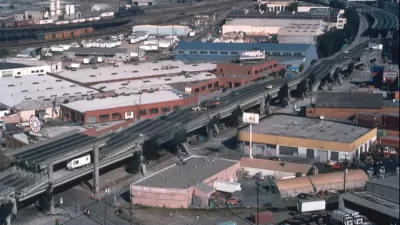Across Los Angeles, more than a thousand concrete buildings built before the mid-1970s are at risk of collapse during an earthquake. With the area overdue for a substantial shaker, time is running out to identify at-risk structures and save lives.
Since the Sylmar earthquake struck in 1971, Los Angeles officials have been aware of the dangers posed by concrete buildings. Though seismic codes were changed in the aftermath of that quake, owners of buildings built before 1971 have never been required to reinforce their structures. Furthermore, efforts to simply identify which buildings are at risk and label the hazardous ones have been blocked repeatedly.
According to Rong-Gong Lin II, Rosanna Xia and Doug Smith, researchers and reporters have catalogued more than a thousand older concrete buildings across Los Angeles County that could be at risk of collapse in a major earthquake. But without official action, it's up to building owners to investigate and invest in any seismic improvements—a cost many are unwilling to bear voluntarily.
"We know darn well that if a bunch of people die, there will be lots of stories, lots of reports, things will change," said Thomas Heaton, director of Caltech's Earthquake Engineering Research Laboratory. "But the question is, do we have to have lots of people die in order to make this change?"
FULL STORY: Concrete risks

Alabama: Trump Terminates Settlements for Black Communities Harmed By Raw Sewage
Trump deemed the landmark civil rights agreement “illegal DEI and environmental justice policy.”

Study: Maui’s Plan to Convert Vacation Rentals to Long-Term Housing Could Cause Nearly $1 Billion Economic Loss
The plan would reduce visitor accommodation by 25% resulting in 1,900 jobs lost.

Planetizen Federal Action Tracker
A weekly monitor of how Trump’s orders and actions are impacting planners and planning in America.

Waymo Gets Permission to Map SF’s Market Street
If allowed to operate on the traffic-restricted street, Waymo’s autonomous taxis would have a leg up over ride-hailing competitors — and counter the city’s efforts to grow bike and pedestrian on the thoroughfare.

Parklet Symposium Highlights the Success of Shared Spaces
Parklets got a boost during the Covid-19 pandemic, when the concept was translated to outdoor dining programs that offered restaurants a lifeline during the shutdown.

Federal Homelessness Agency Places Entire Staff on Leave
The U.S. Interagency Council on Homelessness is the only federal agency dedicated to preventing and ending homelessness.
Urban Design for Planners 1: Software Tools
This six-course series explores essential urban design concepts using open source software and equips planners with the tools they need to participate fully in the urban design process.
Planning for Universal Design
Learn the tools for implementing Universal Design in planning regulations.
Caltrans
Smith Gee Studio
Institute for Housing and Urban Development Studies (IHS)
City of Grandview
Harvard GSD Executive Education
Toledo-Lucas County Plan Commissions
Salt Lake City
NYU Wagner Graduate School of Public Service



























